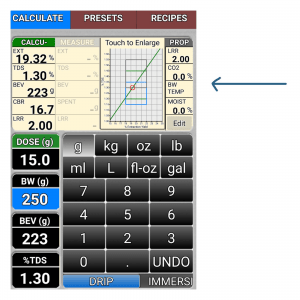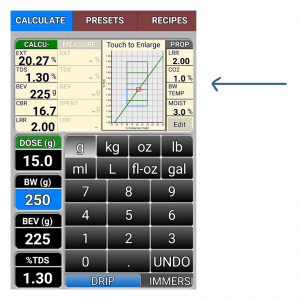How CO2 and H2O Settings Affect our Readings in the Coffee Tools App.
Matt shows you with the help of a screen grab what happens when you change your CO2 and H2O settings in the VST Coffee Tools app.
A Walk-through for Android Users
Here’s a written example of why this matters, with two screenshots from the Coffee Tools App:
In this example, the LRR is set at 2ml per gram and the interstitial liquid is assumed to have a TDS of zero.
Example A: A screenshot from the Android version of the VST App. Notice the 1% CO2 and 3% H2O content

Example B: Here we have CO2 and H2O settings at zero
What looks strange here? Why?
The biggest difference between the two examples is that the extraction yield is 0.95% higher where the app has the settings of 3% moisture and 1% CO2.
This looks strange: Notice that the Bev (g) which stands for beverage weight varies by 2 grams between the two brews with identical brew ratios.
Why? The change in coffee and brew water rate has a follow-on effect where liquid retained ratios are concerned, i.e. less coffee retains less liquid.
This looks strange: You can see the extraction yield in the first example is 0.95% higher — almost 1% which is a really big deal.
Why? In example A, instead of 15g, the app thinks you have 14.45g, because of the settings.
In example B you have 15g (more coffee than example A), and the brew water is 0.45g lower than in example A, too. Where you have the same TDS but with less coffee and a bit more water, you will obtain a higher reading and achieve higher extraction.
A Very Dark Roast Example
A very dark second-crack roast will have a comparatively higher CO2 content because more carbohydrate and chlorogenic acid has turned into more C02 and steam,
